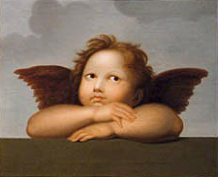The angels of the Sistine


Parody of American Stereoscopy
The angels of the Sistine (also: Raphael's angel) are two putti from the painting The Sistine Madonna . They have been received separately from their original work since around 1800.
history
The oldest evidence of a reception of angels detached from the Sistine comes from 1796 with Johann Heinrich Meyer's copy of Annibale Carraci’s Genius of Fame : Mayer had rearranged or swapped some of the angel figures around the aspiring genius , the right angel was now also off at the bottom of the picture See Raphael's picture. Mayer's painting was destroyed in the fire of the Duchess Anna Amalia Library in 2004 and replaced by a copy. The earliest surviving decoupling as an independent work of art comes from August von der Embde , who dedicated a picture to each of the two angels in 1803/04. A few years later they appeared on everyday objects, such as for the first time in 1815 on Berlin and Meißner porcelain , since then their use has increased more and more. By 1890 they were popular enough in the USA to be parodied: the meat manufacturer NK Fairbank & Co. advertised with two pigs in angelic pose. To this day, the angels of the Sistine appear as statuettes or imprints on a wide variety of profane objects such as candy boxes, coffee cups, umbrellas, as well as soaps and other hygiene items.
An X-ray examination in 1983 showed that they were only subsequently painted over the finished clouds with a thin application of paint. It is not entirely clear whether they actually come from Raphael.
interpretation
These angels fit into the overall composition of Raphael's painting, but in contrast to other putti figures in Renaissance paintings, they are inactive: they do not wear canopies, nor do they present instruments of torture or shoot arrows at lovers, so they can easily be detached from their context. Mirko Derpmann comments: "A baby Jesus or a child's John had the brightener -Designer probably ripped out of the 19th century is not so easily from its original context, [...] When the two angels of the Sistine Chapel but swings the religious context very quietly with. [...] The two are not really angels, they are toddlers with wings. Your closest relatives are not the heavenly hosts, but putti, childlike companions of Cupid and Venus ( erots ). "
Individual evidence
- ↑ Julia Bock: The silent power of familiar motifs, Universitätsverlag Göttingen 2013 p. 135 f. ( Bock Diss.pdf ( Memento from January 7, 2016 in the Internet Archive ))
- ^ Ingeborg Ruthe: Sistine Madonna: High Mass at the Zwinger in: Berliner Zeitung from May 26, 2012
- ↑ Armin Sattler: The Posterboys of the Renaissance (orf.at, accessed on January 7, 2016)
- ↑ Mirko Derpmann: World stars with wings - Raphael's angel as a marketing phenomenon , in: Andreas Henning: The Sistine Madonna. Raphael's cult image becomes 500 , Munich / London / New York 2012, p. 123, quoted from: Julia Bock: The silent power of familiar motifs , Universitätsverlag Göttingen 2013, p. 144

